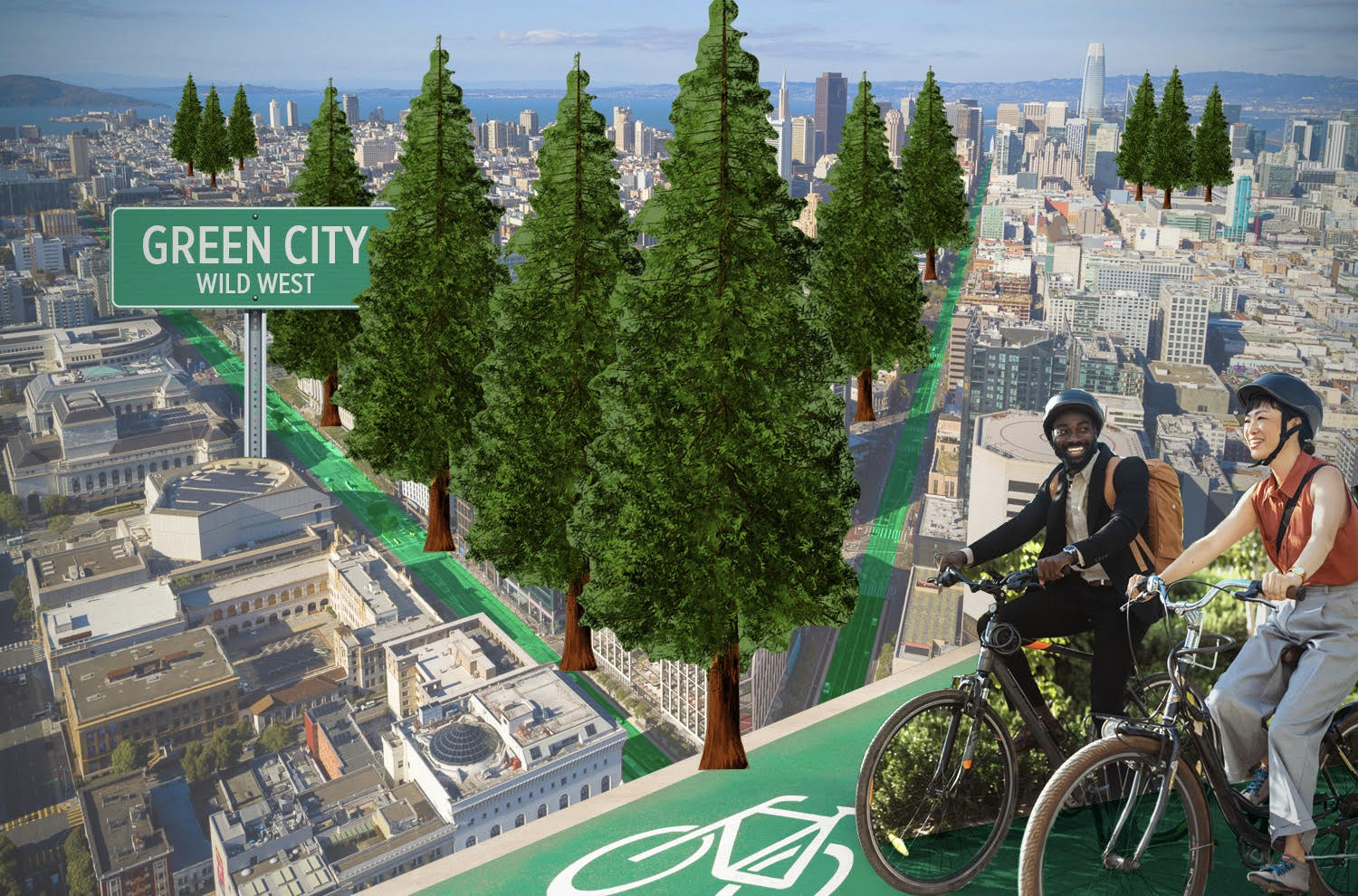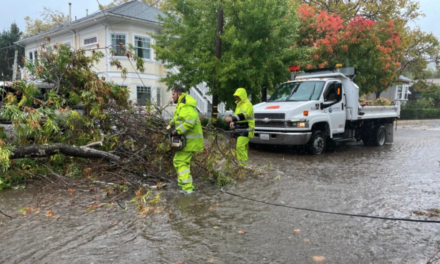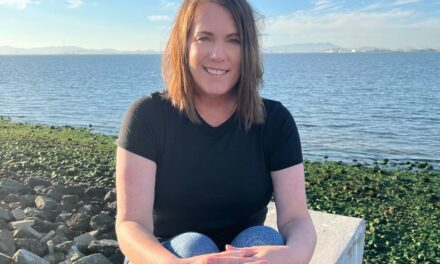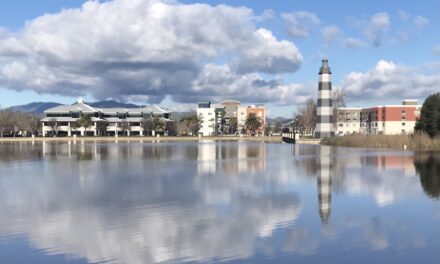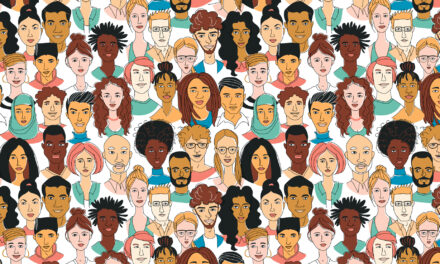Six “Unrealistic” Ideas for Deep Greening San Francisco
At our North Beach farmer’s market last month, a neighbor waved an “Aaron Peskin for Mayor” sign at me. I asked, what is Peskin doing to green San Francisco? The man said: “Yeah it would be nice to have more street trees.”
After meeting Danny Sauter, who is running for San Francisco District 3 Supervisor, at a fundraiser in my hood, I sent him the same query. He too cited his track record with street trees.
Then I listened to the mayoral debate this September.
In all three instances, I was struck by the lack of imagination around how this city could radically change into something future- and climate-forward, rather than where we find ourselves today: stymied by an empty downtown, battling tent cities on our sidewalks, and bickering over the location of pickleball courts.
As we consider our local mayoral race and the November elections, where are the really big ideas? What would it take for San Francisco to become an international destination and vibrant representative of California’s pursuit of a clean, carbon-free environment? Throw the city’s history as a refuge for rainbow living, our existing obsessions with local food and the latest tech, not to mention our electric buses, cars, and scooters, and we have a recipe for success. Why can’t we become the flagship deep green city of the wild west?
Here are a few ideas for how to get there, which readers and politicians are sure to say are “unrealistic.”
Unrealistic Idea 1: Go pedestrian, big time! The city of San Francisco has the perfect small footprint. It’s already walkable. So why not create a car-free zone between Van Ness and the Embarcadero, and between Market and Bay? Some streets can go much greener with forests of trees or food; some can be fully pedestrian or include exercise circuits with trails; some can be for human-powered bicycles, some for transit, taxis, and golf carts. The city has already halfway committed to bike-friendly streets. Why not finish the job, at least in the downtown footprint?
Unrealistic Idea 2: Rather than soliciting the next big anchor store (boring big business as usual!), create a world-class Green Emporium in the Union Square Macy’s building. The upper floors could be an expo-museum showcasing all the latest products improving our energy efficiency, reducing our plastic use, and even monitoring our environmental quality. Another whole floor could feature green building materials for builders and decorators: LEED-certified panes of glass, recycled carpets, sustainable timber, and materials for micro-grids. Mid-level floors could sell the littler stuff: home composting kits, energy efficient washing machines with filters that prevent the escape of microplastics into our sewers, ceramic frying pans, steel water bottles. To mix things up, we could even have a whole floor for “vintage” recycled clothing booths run by the city’s many neighborhood stores of similar ilk.
Unrealistic Idea 3: In the Portola Garden District, restore those vast historic greenhouses with real glass, not plastic, and grow more produce for San Francisco. Build affordable housing right next to it for people who will work in the greenhouses and grow food for the city. Or as a sanctuary city, invite new migrants to live and work there, contributing to their new home and our community.
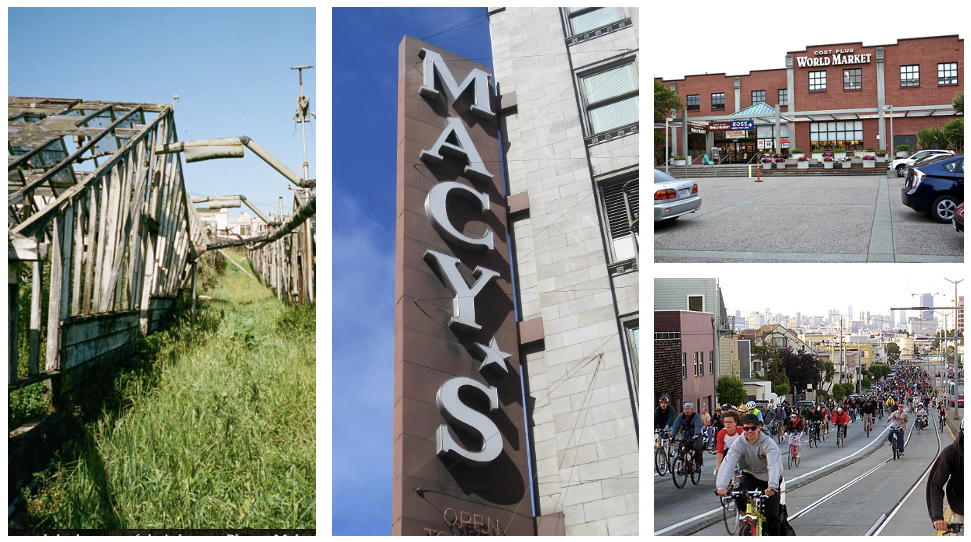
San Francisco sites. Art: KDT
Unrealistic Idea 4: Rehab the empty Cost Plus World Market/Ross/OSH buildings near Fisherman’s Wharf into a sustainable sports complex. How about micro indoor soccer and pickle- and paddleball courts for days that are just too hot or cold to be outside? Pilot artificial turf that’s not made of ground up toxic tires. Drape the courts in old fishing nets, rescued from the Pacific garbage patch. Sell and rent recycled sports equipment on site. Model how gyms and sports complexes can be more environmentally friendly.
Unrealistic Idea 5: Ask each neighborhood to designate one city block that can gradually accommodate the displaced over the next two decades. Imagine committing a whole block to housing San Francisco residents displaced by evictions, toxic air or soil, rent increases, development projects, or the need to retreat from flooding on the ocean coast and bayshore.
Then imagine the waves of refugees fleeing rising heat in our California valleys and increasing violence and drought south of the border. In truth, looking ahead to all the extreme weather and wildfires ahead, the dense parts of our Bay Area cities may soon become one of the safest places for anyone to live, absent a major earthquake. Let’s face it, people may soon be fleeing back to the city. We should get ready!
Unrealistic Idea 6: Market Street is the biggest, saddest, most daunting area to refresh of all. While our city’s neighborhoods seem to be flourishing, the heart of San Francisco is sickly — disconnected from the region and city it serves, and full of unaffordable penthouses and lofts and empty glass office towers. We can’t just leave it like that. Ideas here may require some truly outside the box thinking.
Recreate Gold Rush era bars and stores with one block and build a space-age solar village on another? Add second-floor greenhouse bridges? Consider a linear lake or new creek to absorb heavy rains? Demolish whole buildings or blocks and offer them as Land Back projects, or convert them to urban forest? Use the rubble to rebuild the Embarcadero sea wall? Market’s streetscapes need more variety.
If we are to be saddled with the label of “coastal elites,” let’s show the rest of the country what we’re really made of (more than silicon). There are a million ways to make our city more deeply green, more truly equitable, more locally sustainable, more inviting to the outside world.
San Francisco needs a new identity built on our swashbuckling Western embrace of new ideas and long history of environmental stewardship. Those are the ideas of the future. And I don’t hear any of them in current local politics. Street trees will not be nearly enough.
Other Recent Posts
Gleaning in the Giving Season
The practice of collecting food left behind in fields after the harvest is good for the environment and gives more people access to produce.
New Study Teases Out Seawall Impacts
New models suggest that sea walls and levees provide protection against flooding and rising seas with little effect on surrounding areas.
Oakland High Schoolers Sample Local Kayaking
The Oakland Goes Outdoors program gives low-income students a chance to kayak, hike, and camp.
Growing Better Tomatoes with Less Water
UC Santa Cruz researchers find the highly-desired ‘Early Girl’ variety yields more tomatoes under dry-farmed conditions.
Santa Clara Helps Homeless Out of Harm’s Way
A year after adopting a controversial camping ban, Valley Water is trying to move unsheltered people out of the cold and rain.
The Race Against Runoff
San Francisco redesigns drains, parks, permeable pavements and buildings to keep stormwater out of the Bay and build flood resilience.
Learning the Art of Burning to Prevent Wildfire
In Santa Rosa’s Pepperwood Preserve, volunteers are learning how controlled fires can clear out natural wildfire fuel before it can spark.
COMMENTS
MICHELLE ORR, Engineer
One of my favorite unrealistic ideas is to set up systems for a sharing economy that supports people being able to live comfortably on a smaller footprint. This means walkable neighborhoods, ride-shares and car shares (like zip car) in every neighborhood, neighborhood networks of spare bedrooms to house visiting family and friends (open to neighbors only to avoid the AirBNB effect; no more oversized houses with a rarely used guest bedrooms), lots of public open space, workshop and tool sharing, etc.
PETER BAYE, Botanist
I like the urban farm greenhouse rehab idea. Here’s a nerdy horticultural detail to consider. Though it’s counter-intuitive, traditional glass pane greenhouses, though nostalgic, aren’t necessarily better carbon-efficient alternatives to the best plastic for the job, polycarbonate. Polycarbonate panes are a couple hundred times more shatter-resistant than glass, much better insulators for heat retention, optimally diffuse sunlight for plant growth, and last decades. Considering the risks of storm damage for greenhouse glass ahead – remember the 1995 storm destruction of the Conservatory of Flowers in GG Park? – polycarbonate is higher feasibility and cost-efficiency, and probably lower life-cycle carbon footprint, too, compared with glass manufacture or recycling unless it’s done with [not available] solar furnaces!
Urban farming in SF, mixed greenhouse, open-field cropland, makes sense for a lot of underutilized non-park public lands, including the tops of reservoirs that are used exclusively for solar panels. It’s now possible to combine solar farms and food farms with modified vertical panels.
The other big climate adaptation for SF that needs total overhaul is groundwater management and lake management – out of sight, out of mind except for a few agency participants! Lake Merced is still captive of golf fertilizer seeps and runoff, and vast groundwater resources are still wildly nutrient loaded. Lake Merced eutrophication will get a lot worse with warming, and it’s shockingly bad now.
NICOLE BECK, Scientist
I share your vision! My Ted talk about rainwater strategies for resilience gives you a sense of my focus.






